NCERT Exemplar Class 11 Biology Solutions Chapter 15 Plant Growth and Development
The NCERT Exemplar Class 11 Biology Solutions Chapter 15 Plant Growth and Development helps students understand the various phases in a plant's life and how elements influence plant growth. This chapter describes important concepts like phases of plant growth, the function of hormones, and seed dormancy. Students are able to use these explanations in order to understand concepts, which are highly useful for examinations. Working through questions in NCERT exemplar solutions is an excellent study method, as the answers contain a wide variety of objective questions and examples from real life.
This Story also Contains
- NCERT Exemplar Class 11 Biology Chapter 15 Solutions Multiple Choice Questions
- NCERT Exemplar Class 11 Biology Chapter 15 Solutions -Very Short Answer Question:
- NCERT Exemplar Class 11 Biology Chapter 15 Solutions-Long Answer Type Questions:
- NCERT Exemplar Class 11 Biology Chapter 15 Solutions- Short Answer Type Questions:
- Major Topics and Subtopics in NCERT Class 11 Biology Chapter 15 Plant Growth and Development
- Approach to Solve NCERT Exemplar Class 11 Biology Solutions Chapter 15
- Advantages of NCERT Exemplar Class 11 Biology Chapter 15 Solutions
- Important Questions from NCERT Exemplar Class 11 Biology Chapter 15
- NCERT Exemplar Class 11 Biology Solutions Chapter Wise
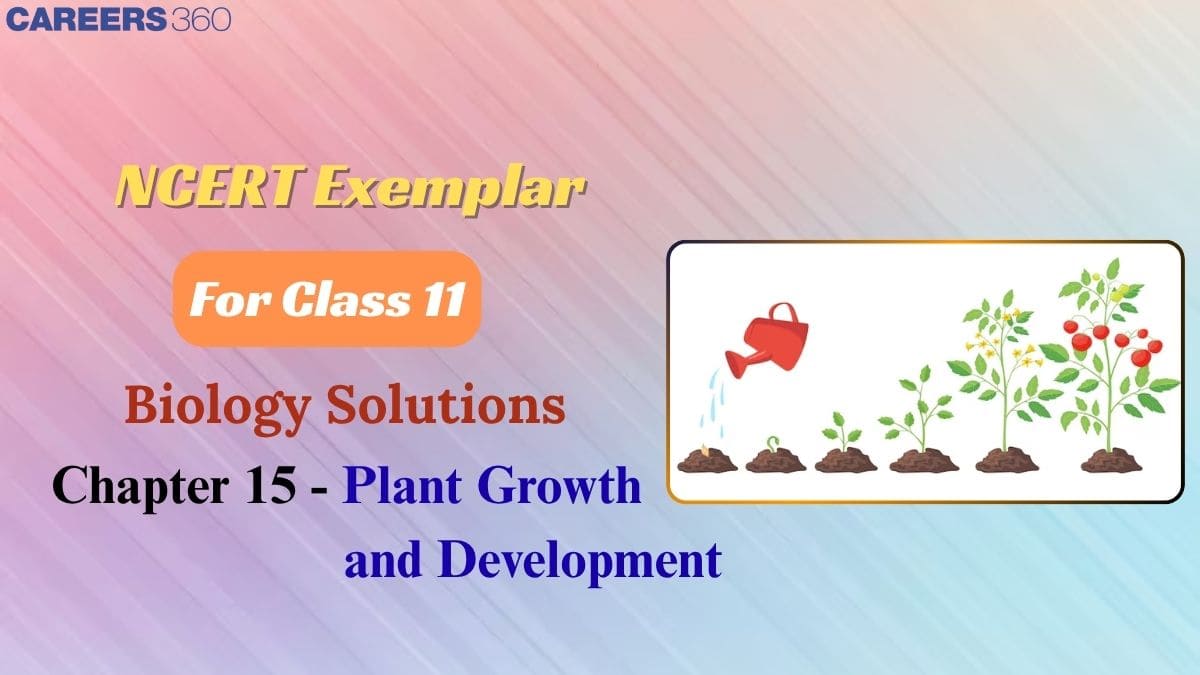
By practising these questions every day, students can improve their analytical minds and accuracy during school exams and competitive exams like NEET. Solving the MCQs by studying these solutions helps students understand the chapter and improves their science marks overall. The sample solutions also provide confidence as well as an advantage to students while solving the questions given in the NCERT Class 11 Biology Book.
NCERT Exemplar Class 11 Biology Chapter 15 Solutions Multiple Choice Questions
Different forms of questions, like MCQs, short answers, and long answers with the required diagrams, are provided below. Practising NCERT Exemplar Class 11 Biology Solutions Chapter 15 will help you understand the pattern and these concepts easily and effectively.
Question:1
Answer:
The answer is option (b), hastening the ripening of fruits.
Explanation: Ethylene is a naturally occurring hormone within fruits that monitors the ripening of the fruit by inducing and regulating many chemical and biochemical activities.
Question:2
Coconut water contains
(a) ABA
(b) Auxin
(c) Cytokinin
(d) Gibberellin
Answer:
The answer is option (c) Cytokinin
Explanation: Coconut water hosts an abundance of cytokinin, which helps regulate cell growth and cell division.
Question:3
Answer:
The answer is option (d) Cytokinin
Explanation: During apical dominance, cytokinin antagonises the auxin and triggers outgrowth. The presence of cytokinin can induce the movement of nutrients towards the site where it is present. In lateral buds, the cytokinin present encourages growth despite the lateral buds having apical buds.
Therefore, cytokinin is antagonistic to auxin, and thus, apical dominance can be overcome through the use of
cytokinin.
Question:4
Column I | Column II |
A. IAA | i) Herring sperm DNA |
B. ABA | ii) Bolting |
C. Ethylene | iii)Stomatal closure |
D.GA | iv) Weed-free lawns |
E. Cytokines | v) Ripening of fruits |
Options:
(a) A- (iv), B - (iii), C -(v), D - (ii), E- (i)
(b) A- (v), B - (iii), C -(iv), D - (ii), E- (i)
(c) A- (iv), B - (i), C -(v), D - (iii), E- (ii)
(d) A- (v), B - (iii), C -(ii), D - (i), E- (iv)
Answer:
The answer is option (a) A- (iv), B - (iii), C -(v), D - (ii), E- (i)
Explanation: IAA is used for weed-free lawns, ABA causes stomatal closure, ethylene induces fruit ripening, GA promotes bolting, and cytokinins were first discovered in herring sperm DNA.
Question:5
Answer:
The answer is option (b): Prevent aerobic respiration by checking the entry of O2.
Explanation: To avoid the ripening of the apple, in order for it to stay fresh for a much longer time, aerobic respiration is prevented because it makes the apple rot much faster.
Question:6
Answer:
The answer is option (d) All the above
Explanation: The growth can be in lateral or apex regions and can cause an enlargement in height or weight; all of these changes are collectively termed growth.
Question:7
Answer:
The answer is option (b). When two hormones act together and contribute to the same function.
Explanation: When two or more hormones function mutually to deliver a certain effect, their outcomes are called synergistic. These results can be additive or complementary.
Question:8
Answer:
The answer is option (b). Plant development is dependent on the environment.
Explanation: Plants take distinct paths in response to environmental changes and different stages of life to develop various types of compositions. This entire ability is called plasticity.
Question:9
Answer:
The correct answer is option (c) Gibberellin
Explanation: Gibberellin increases the length of the stem and thus increases the amount of sugar in sugarcane.
Question:10
ABA acts antagonistically to
(a) Ethylene
(b) Cytokinin
(c) Gibberellic acid
(d) IAA
Answer:
The answer is option (c) Gibberellic acid
Explanation: ABA's function is to inhibit growth and to be antagonistic to it; the correct option should encourage and promote growth, and gibberellin does, so it is the correct option.
Question:11
Answer:
The answer is option (b) Flower once and die.
Explanation: Monocarpic plants are known to flower, set seeds, and then die.
Question:12
The photoperiod in plants is perceived at
(a) Meristem
(b) Flower
(c) Floral buds
(d) Leaves
Answer:
The answer is option (d) Leaves
Explanation: Leaves are the primary producers and receive light energy and thus are key players in the photoperiod.
NCERT Exemplar Class 11 Biology Chapter 15 Solutions -Very Short Answer Question:
The detailed answers to the Very Short Answer questions are given below:
Question:1
Answer:
(a) exponential phase
(b) auxin
(c) cytokinin
(d) Leaves
Question:2
Answer:
(a) Gibberellic acid
(b) Cytokinin
(c) Ethylene
(d) Abscisic acid
Question:3
Answer:
Absolute Growth Rate (AGR):
A G R = W 1 − W 0 t = 19 − 5 7 = 2 cm/day
Relative Growth Rate (RGR):
R G R = ln W 1 − ln W 0 t = ln 19 − ln 5 7 = ln ( 19 5 ) 7 = 1.335 7 ≈ 0.19 per day
A G R = 2 cm/day ; R G R ≈ 0.19 per day
Question:4
(a) Give two functions of this phytohormone.
(b) Which property of gibberellin caused foolish seedling disease in rice?
Answer:
(a) Two functions of the Gibberellin phytohormone are that encourage the sprouting of the seed by disrupting seed dormancy. In rosette plants, gibberellin induces the development of internodes; it encourages the process of bolting.
(b) The surplus quantity of gibberellin produced by the fungus causes foolish seedling disease in rice. The surplus of gibberellin thus induces the plants' development and hastens the growth in internodes. This thus results in the plant growing too tall and being
unable to bear its own weight.
Question:5
Answer:
male, female, female, male
Gibberellins promote the formation of male flowers on genetically female plants in Cannabis, whereas ethylene promotes the formation of female flowers on genetically male plants.
Question:6
Answer:
Long-Day plants (LDP) | Short Day plants (SDP) | Day Neutral Plants (DNP) |
Strawberry | Xanthium | Sunflower |
Henbane (Hyoscyamus niger) | Rice | Tomato |
Spinach | Bryophyllum | Maize |
Question:7
Answer:
Ethylene encourages the development and increases the number of female flowers in monoecious species, as it is known to be a growth regulator that has a feminising effect.
Question:8
Where are the following hormones synthesised in plants?
(a) IAA
(b) Gibberellins
(c) Cytokinins
Answer:
(a) IAA is synthesised mainly in the shoot apices, primarily in the growing apices of plants. This includes the leaf primordia and developing seeds.
(b) Gibberellin hormone is synthesised in plants primarily in apical shoot buds, root tips, as well as developing seeds.
(c) Cytokinin is synthesised in plants primarily in roots, the endosperm region in the seed, as well as developing shoot buds and growing embryos.
Question:9
Answer:
Regular trimming makes the plants bushy, as this growth is primarily based on the apical dominance of the plants. The apical dominance thus does not allow and, in fact, prevents the growth of nearby lateral buds. This happens through the release of certain
auxins. If the shoot apex or the apical bud is removed, then the lateral buds can grow and sprout. This can lead to bushy growth.
Question:10
Answer:
The physiological processes in plants that are affected by light are: -
Photosynthesis,
This is the process through which the plant manufactures its own food in the presence of sunlight by utilising inorganic substances.Transpiration
This is the process by which plants experience water loss in the form of vapour or dew formed on the leaves, primarily through the stomata. This process requires sunlight as the stomata are active and functioning only in the presence of sunlight.Photoperiodism
This process typically decides the flowering of the plant, and the number of light hours affects this growth.
Question:11
In the figure of the Sigmoid growth curve given below, label segments 1, 2, and 3.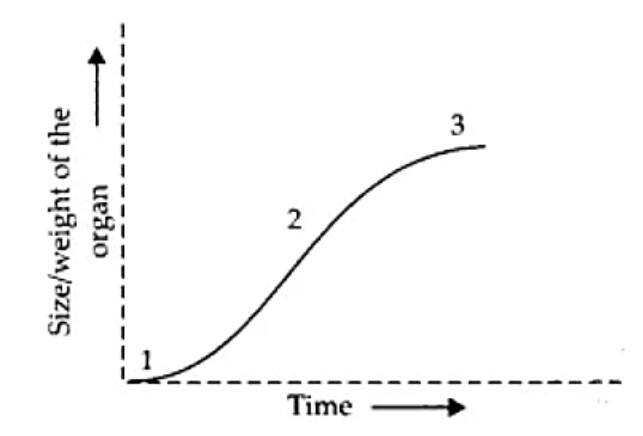
Answer:
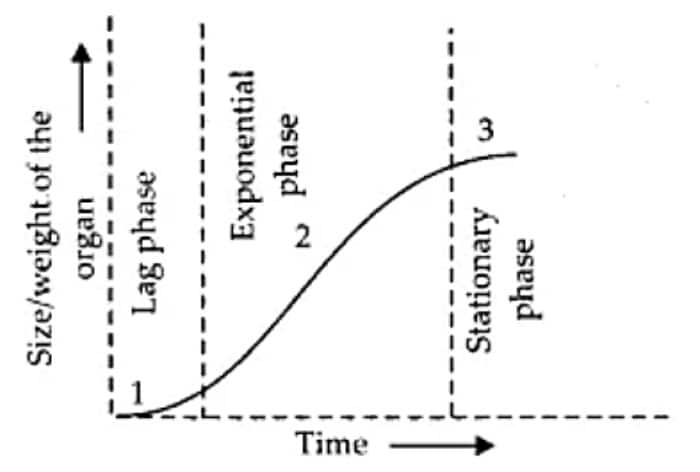
Lag phase.
Exponential phase and
Stationary phase
Question:12
Answer:
Yes, unicellular organisms also grow. Growth in them is measured not by size increase but by cell number, as they reproduce by cell division. Thus, population growth (increase in the number of cells) is taken as the parameter of growth.
Question:13
Answer:
The rice seedlings infected with the fungus Gibberella fujikuroi are called foolish seedlings because the rice plants that get infected with the fungus grow excessively in length in comparison to the rice plants that are not infected. The height of the plant becomes disproportionate and is too much for the plant to bear, and it cannot support the weight of the plant, which leads to the plant's death ultimately. Hence, the plant causes its own death due to the infection by the fungus and is called foolish seedlings.
NCERT Exemplar Class 11 Biology Chapter 15 Solutions-Long Answer Type Questions:
The detailed answers to the Long Answer questions are given below:
Question:1
Answer:
Some plants require special extrinsic conditions in order to commence the flowering stage, and one of the requirements can be a low temperature. Thus, the plants remain vegetative during the summer season and wait till they receive a low temperature to begin bearing flowers. Waiting for lower temperatures helps prevent precocious early active reproductive development. This helps the plant to gain proper maturity and develop within the vegetative state before advancing to the reproductive stage. This is called the vernalisation. Some plants have separate spring and winter varieties. For example, spring wheat is planted in the spring season and comes to flower and fruit right at the end of the season, but if the winter varieties are sown in the same season, then they will not bear flowers and fruits as compared to the spring variety.
Instead, the winter is planted in the autumn, and during the winter, they form the seedlings. The seedlings resume their growth in the spring season and bear flowers during the summer. The winter wheat requires specific low temperatures to begin sprouting and maturing.
Question:2
Answer:
(a) These plants usually germinate and grow as seedlings throughout winter. They only resume growth when it is summer and are finally harvested around the upcoming midsummer. This is because these plants require low temperatures to bear flowers and
fruits and are able to finish their vegetative phase of growth over the period of winter and summer.
(b) This process mentioned here is called vernalisation.
(c) Gibberellin hormone can replace cold treatment effectively.
Question:3
Answer:
(a) Ethylene hormone is gaseous in nature.
(b) Auxin is responsible for phototropism.
(c) Ethylene hormone induces female characters in the flowers of cucumbers.
(d) Synthetic auxin (2,4-D) is used to kill weeds
(e) Gibberellin hormone induces flowering in long-day plants
NCERT Exemplar Class 11 Biology Chapter 15 Solutions- Short Answer Type Questions:
The detailed answers to the Short Answer questions are given below:
Question:1
Answer:
Nicotiana tabacum is a short-day plant, and these plants require much less exposure to light than the required amount in normal plants. They demand a continuous critical dark period, which, if interrupted, can affect the flowering of the plant. These plants require a photoperiod less than the generally required one and play a key role in flowering. This is due to the fact that flowering is regulated by a hormone that is present in the leaves and requires a dark photoperiod to migrate to the required places in the shoot apices.
Question:2
What are the structural characteristics of
(a) Meristematic cells near the root tip
(b) The cells in the elongation zone of the root
Answer:
(a) Meristematic cells are located in the zone, which is the growing point of the root, and in an active state of cell division. The cells are closely arranged and thin-walled and have dense protoplasm. They are essential for the growth of roots.
(b) In this zone, the cells are newly formed and lose the ability to divide, which is why they elongate and rapidly increase the length of the root. They have a large number of small vacuoles. These vacuoles fuse to form one large central vacuole. This is what
causes the cells to elongate and grow longitudinally in this region.
Question:3
Answer:
Animals and plants have different growth patterns and habits. Animals experience growth of definite, determinate form, which means they experience limited growth or stop growing after attaining maturity. Plants, on the other hand, can experience growth in definite or indefinite, and indeterminate form. They can stop growing after attaining the maturity of developing leaves and flowers or parts like the stem, and their branches can continue to grow. Plants experience continuous growth since they contain meristematic areas with potential for cell division, whereas animals have cell division only to replace and repair, and not for the purpose of growth.
Question:4
Answer:
(a) To facilitate growth, the meristematic cells, through mitotic division, divide into daughter cells. The cells ranging from the root to the shoot apical meristem are separated into different categories as they mature and can perform specific functions. This phenomenon is called differentiation. During this phase, the cells experience critical structural modifications in the protoplasm and cell wall.
(b) Under certain conditions, the differentiated living cells can divide mitotically after recovering the ability to divide. This phenomenon is called de-differentiation. Sometimes, the de-differentiated cell may become the meristem; for example, fully differentiated parenchyma cells form the meristems and interfascicular cambium and cork cambium.
(c) The cells formed by de-differentiated cells can lose their capacity to reproduce and thus mature to perform specific functions. This is known as redifferentiation. For example, the secondary cortex and cork are prime examples, as well as the cambium, which dedifferentiates to form the cortex.
Question:5
Answer:
(a) Auxin precursors are the raw substances utilised in the process of initial formation and synthesis of auxins. For example, IAA's auxin precursor is tryptophan.
(b) Anti-auxins are compound substances that restrict the action of auxins. For example, TIBA and p-chlorophenoxy isobutyric acid (PCIB).
(c) Synthetic auxins are auxins that are artificially synthesised and do not occur naturally in plants. For example, 2:4-D, NAA.
Question:6
The role of ethylene and abscisic acid is both positive and negative. Justify this statement.
Answer:
Both ethylene and abscisic acid have positive and negative effects.
Positive Effects of Ethylene:
Ethylene acts as a hormone that induces apical dominance and encourages horizontal growth
It interrupts the dormancy of seeds and buds
Ethylene aids in the initiation of the root
Ethylene also helps in the ripening of certain fruits
Negative Effects of Ethylene:
Ethylene causes the abscission of leaves because it hastens the senescence of leaves
Ethylene delays longitudinal development in the plant
Ethylene extends the dormancy of lateral buds
Positive Effects of Abscisic Acid:
Helps reduce water loss in the form of transpiration
Induces flowering in short-day plants
In certain plants, such as roses, abscisic acid encourages parthenocarpic development as well as the rooting of stem cuttings
Helps plants form resistance to environmental stress
Promotes root initiation in certain plants
Negative Effects of Abscisic Acid:
Encourages the abscission of flowers and fruits and induces leaf senescence.
Inhibits and slows down the cambial activity
Retards the effect and functioning of growth hormones.
Promotes dormancy in seeds and
Question:7
Answer:
Plant hormones mostly work together, complementary to each other. Plant hormones can have both synergistic and antagonistic interactions, which affect the plant tissues. A single hormone can have multiple effects, while multiple hormones can target and aim to achieve just one effect. Therefore, it can be exceedingly difficult to identify a single hormone according to its particular effect on plant metabolism and systems. Moreover, plant hormones function in the presence of a lot of extrinsic factors, which are needed for the reaction. Thus, it is difficult to assign any effect seen to any single hormone.
Question:8
Answer:
This phenomenon, by which the terminal/apical bud suppresses the growth of the lateral buds, is called apical dominance. On removal of the apical bud, the lateral buds are allowed to sprout, which produces bushy growth. The apical bud restricts the growth of the lateral buds through the release of certain auxins. Thus, the auxin causing apical dominance can be countered with cytokinin. This attracts nutrients and helps the lateral buds to grow by acting as an antagonist.
Question:9
Answer:
Plant hormones are produced by individual cells in the regions where they are essential to the plants. To take an example, auxin is synthesised in the cells where there are growing apices. The vascular system of plants is where plant hormones are translocated. Other examples include the Abscisic acid produced in many parts of plants, which is transported through diffusion and transport channels.
Question:10
Answer:
Various plant hormones and other scientific research have been led by accidental means. Gibberellin was discovered accidentally, and Charles Darwin and his son, Francis Darwin, accidentally came across the auxin. They noticed that coleoptiles of canary grass reacted to unilateral illumination through growth in the direction of light. After some time, F W Went separated auxin from coleoptiles of oat seedlings.
The term used for accidental discovery is 'serendipity'
Question:11
To get carpet-like grass, lawns are mowed regularly. Is there any scientific evidence for this?
Answer:
Ans. Mowing regularly means the trimming of the apical parts of the plant, which thus causes the sprouting and faster growth of lateral branches. Thus, apical dominance is prevented and restricts the longitudinal growth of the plant. Since the apices are removed, the auxins released due to the apical buds inhibit the lateral buds from getting mobilised and encourage the growth of lateral branches. This helps in maintaining carpet-like lawns.
Question:12
Answer:
The presence of the following characteristics would indicate meristematic cells in the slides showing different types of cells:
(a) Thin cellulose wall
(b) Dense cytoplasm with a large nucleus
(c) Cells displaying cell division, like mitosis and other various stages.
(d) Smaller-sized vacuoles or even negligible vacuoles.
If the above features are absent, then it can be determined that the cells are incapable of division.
Question:13
Is there any difference between the two processes? Discuss it with respect to plant growth.
[Hint: Elasticity (reversible), plasticity (irreversible)]
Answer:
Referring to an experiment with oat coleoptile, the auxin hormone induces the shoot tip tending in the direction of the light source. This process is irreversible and is known as plasticity. It is the plant's ability to adjust to the surrounding environmental conditions. If weight is attached to the coleoptile segment, the weight causes bending and thus stretches the plant. If the weight is removed, the shoot of the plant returns to the original position, meaning that this change is reversible. This is known as elasticity.
Question:14
(a) This is which part of a dicotyledonous plant?
(b) If we remove part I from the plant, what will happen?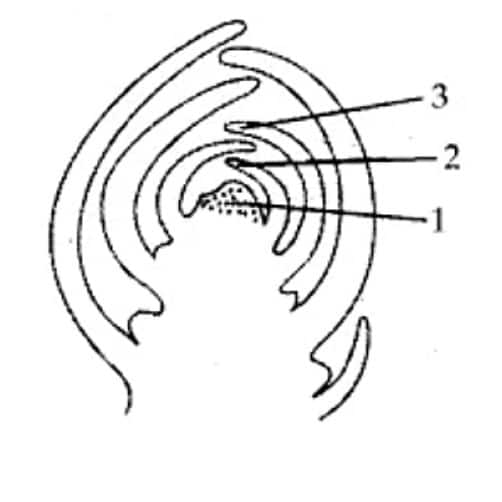
Answer:
(a) This diagram displays the shoot apex of the dicotyledonous plant.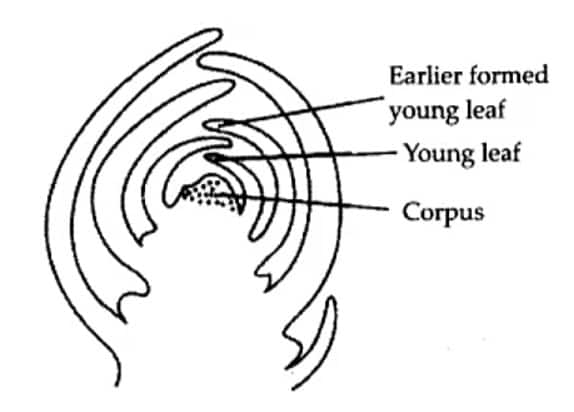
(b) Removal of the shoot apex will prevent apical dominance. This will, in turn, help in the growth of lateral branches.
Question:15
Answer:
The growth of a plant can be said to be indeterminate. This is because a part of a plant can grow infinitely, i.e., always growing and forming new organs to replace the older ones. This is not the case for animals. Animal growth is limited and stops after a certain age when they mature. This is why one can say that the growth and differentiation in plants and animals are different.
The sponges can be said to be an exception in the animal kingdom. This is because they are the animals that show a cellular level of organisation. They depict the characteristics of open-ended growth, but cannot be called one since they cannot grow beyond a certain size.
Question:16
Define parthenocarpy. Name the plant hormone used to induce parthenocarpy.
Answer:
Parthenocarpy is the process of formation and development of fruits that occurs without the use of any kind of fertilisation. The fruit produced by this process does not contain seeds. Fruits such as pear, banana, pineapple, and some varieties of papaya are parthenocarpic fruits. In order to induce parthenocarpy, auxins, cytokinins, and gibberellins are utilised.
Question:17
Answer:
To have seedless watermelons, there needs to be a cross-hybridisation that occurs between a tetraploid female parent and a diploid male. This results in a triploid plant which has three sets of chromosomes. This particular genome thus produces the watermelon to not contain seeds.
Question:18
Answer:
The weed can be effectively eliminated by using weedicides. One can use the 2:4-D and 2:4, 5-T, which do not affect mature monocotyledons. This is a synthetic auxin and is widely used by farmers, but it is to be used with caution and restraint so as not to hamper the crops.
Question:19
Answer:
(a) On germination of the seed, shoots with leaves are produced at first as the plant is gradually entering the vegetative growth phase of the plant. The leaves begin to manufacture food, and the photoperiod follows to determine the flowering of the plant.
The leaves are produced to regulate the process of photosynthesis and produce food, which could be utilised in sexual reproduction. This marks the beginning of the important flowering process as well.
(b) The vegetative phase marks immense growth and aids the plant in gaining maturity. Then the process of reproduction commences, and flowering also occurs. The vegetative phase is necessary to prepare the plant for the upcoming process and for it to develop the necessary structures. Thug, the vegetative phase of growth is necessary for the survival of the plant species. The flowering phase depends on this phase to provide for nourishment.
Question:20
Answer:
(a) Exponential
(b) Auxin
(c) Cytokinin
(d) Phytochrome
Major Topics and Subtopics in NCERT Class 11 Biology Chapter 15 Plant Growth and Development
The topics and subtopics of the chapter are given below-
Growth
Plant growth generally is indeterminate
Growth is measurable
Phases of Growth
Growth Rates
Conditions for Growth
Differentiation, Dedifferentiation, and Redifferentiation
Plant Growth Regulators
The discovery of plant growth regulators
Physiological Effects of Plant Growth Regulators
Auxins
Gibberellins
Cytokinins
Ethylenes
Abscisic Acid
Also, read the NCERT Solution subject-wise
Approach to Solve NCERT Exemplar Class 11 Biology Solutions Chapter 15
To solve the Plant Growth and Development questions effectively, follow these simple steps:
Understand growth, differentiation, and plant growth regulators as main concepts from the textbook.
Revise germination, photoperiodism, and vernalization as main processes through brief notes.
Practice all the questions given in the NCERT Exemplar Class 11 Biology Solutions Chapter 15 with step-by-step, detailed solutions for clarity.
Draw and label diagrams to improve understanding of plant structure and developmental stages.
Clarify doubts and review regularly to improve retention and application abilities.
NCERT Exemplar Class 11 Solutions for other subjects
Advantages of NCERT Exemplar Class 11 Biology Chapter 15 Solutions
The chapter Plant Growth and Development explains how plants grow, mature, and respond to environmental signals through hormones and various growth processes. Solving exemplar questions helps students understand these concepts clearly and easily without any confusion.
- Plant Growth and Development Class 11 NCERT Exemplar covers topics like growth phases, differentiation, dedifferentiation, and redifferentiation.
- It also improves clarity on the plant hormones such as auxins, gibberellins, cytokinins, ethylene, and ABA.
- Regular practice of these solutions improves accuracy, and students will also know how to write answers in the exam.
- Questions from this chapter are frequently asked in the board exams and competitive exams like NEET, so students can improve their memory retention by solving the questions.
Important Questions from NCERT Exemplar Class 11 Biology Chapter 15
Question 1: Ethylene is primarily responsible for:
Option 1. Delaying fruit ripening
Option 2. Hastening fruit ripening
Option 3. Promoting seed dormancy
Option 4. Stimulating root growth
Answer:
Ethylene is a natural plant hormone that plays a central role in regulating and accelerating the ripening process of many fruits. As fruits mature, they produce increasing amounts of ethylene, which initiates and coordinates various physiological changes such as softening, color change, and the development of aroma and flavor. This hormone is especially important in climacteric fruits like bananas, tomatoes, and apples, where a rise in ethylene production leads to rapid ripening even after harvest. Therefore, ethylene is primarily responsible for hastening, not delaying, fruit ripening.
Hence, the correct answer is option (2) hastening fruit ripening
Question 2. Growth can be measured in various ways. Which of these can be used as parameters to measure growth?
Option 1. Increase in cell number
Option 2. Increase in cell size
Option 3. Increase in length and weight
Option 4. All the above
Answer:
Generally speaking, plant growth is indeterminate; plants can continue to develop for the duration of their lives. This is because specific parts of their bodies contain meristems, which can divide and reproduce themselves. Growth is Measurable: Growth at the cellular level results from an increase in protoplasm, which is hard to quantify. Plant growth is quantified using a variety of techniques, such as a rise in fresh weight, volume, dry weight, or cell number.
Hence, the correct answer is option (4) All the above
Question 3. Ethylene is used for
Option 1. Retarding the ripening of tomatoes
Option 2. Hastening the ripening of fruits
Option 3. Slowing down the ripening of apples
Option 4. Both b and c
Answer:
Ethylene is a naturally occurring hormone within fruits that monitors the ripening of the fruit by inducing and regulating many chemical and biochemical activities. Fruit Ripening: In climacteric fruits such as apples, bananas, tomatoes, etc., exposure of mature fruits to ethylene results in respiration climacteric followed by additional production of ethylene, leading to the hastening of the ripening process.
Hence, the correct answer is option (2), hastening the ripening of fruits.
Also, check the NCERT Books and the NCERT Syllabus here
NCERT Exemplar Class 11 Biology Solutions Chapter Wise
The biology chapter-wise exemplar solutions of Class 11 are given below:
Frequently Asked Questions (FAQs)
Abscisic acid (ABA) is called a "stress hormone" because its synthesis and release are strongly stimulated by environmental stresses like drought and waterlogging, and it plays a crucial role in enabling plants to tolerate these abiotic stresses.
Temperature plays a crucial role in seed germination, with optimal temperatures being essential for the process, while extreme temperatures can negatively impact or even inhibit it.
Photoperiodism, the plant's response to the length of day and night, is crucial for regulating flowering and other developmental processes, enabling plants to adapt to seasonal changes and optimize their reproductive success.
Plant growth progresses through distinct phases: meristematic (cell division), elongation (cell enlargement), and maturation (cell differentiation).
The main phases of growth are. These are well-explained in the NCERT Exemplar Class 11 Biology Solutions Chapter 15 Plant Growth and Development.
Meristematic phase (active cell division at root and shoot tips),
Elongation phase (cells enlarge in size), and
Maturation phase (cells attain final size and function)
Students will learn about plants growth, differentiation, dedifferentiation, growth regulators, vernalisation and photoperiodism from the NCERT Exemplar Class 11 Biology Solutions Chapter 15 Plant Growth and Development.
Dedifferentiation occurs when mature cells regain the ability to divide under certain conditions, such as the formation of meristematic tissue from parenchyma.
Redifferentiation is when these dedifferentiated cells lose the capacity to divide again and become specialized for specific functions
Seed dormancy is a state where viable seeds fail to germinate even under favorable conditions, acting as a survival mechanism that prevents germination in unsuitable environments. Dormancy can be broken by various methods, including scarification, stratification, and specific environmental conditions.
Gibberellins promote seed germination by breaking dormancy, stimulating the synthesis of hydrolytic enzymes like amylase, and mobilizing stored nutrients, ultimately enabling the embryo to grow.
Popular Questions
Courses After 12th
Applications for Admissions are open.
As per latest syllabus. Physics formulas, equations, & laws of class 11 & 12th chapters
JEE Main Important Chemistry formulas
Get nowAs per latest syllabus. Chemistry formulas, equations, & laws of class 11 & 12th chapters
JEE Main high scoring chapters and topics
Get nowAs per latest 2024 syllabus. Study 40% syllabus and score upto 100% marks in JEE
JEE Main Important Mathematics Formulas
Get nowAs per latest syllabus. Maths formulas, equations, & theorems of class 11 & 12th chapters
